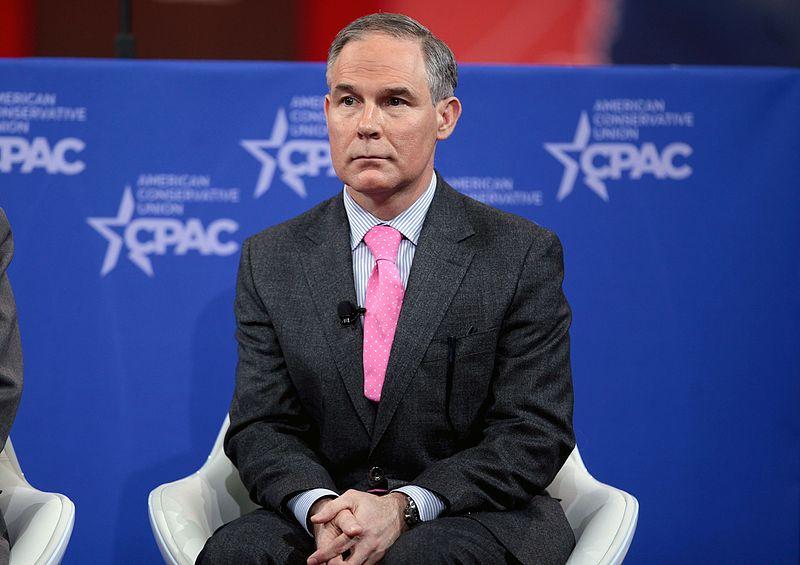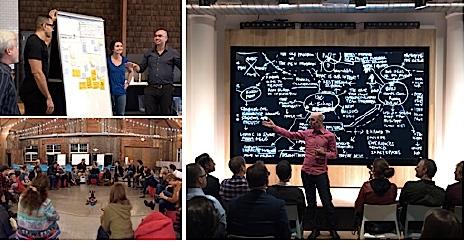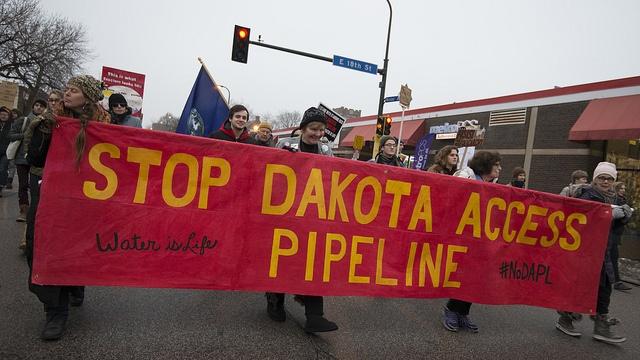Koch Brothers Pushing Scott Pruitt Pick for EPA


By Elliott Negin
The two dozen nonprofit groups and Senate committee members defending Scott Pruitt, President Donald Trump’s nominee for Environmental Protection Agency (EPA) administrator, have at least two things in common.
Like Pruitt, they’re climate science deniers. And, like Pruitt, most of them are funded by Charles and David Koch, the billionaire brothers who own the coal, oil and gas conglomerate Koch Industries.
That funding helps explain why they all consistently misrepresent the scientific consensus on climate change. After all, money buys influence, and since 1997, Koch foundations have paid a network of think tanks and advocacy groups more than $88 million to spread climate science disinformation — more than twice what ExxonMobil, the second-biggest denier-network funder, has spent. Likewise, Koch Industries has contributed $38.5 million to federal candidates over the last 25 years and spent another $117 million since 1998 on lobbying.
The Kochs didn’t endorse Trump for president, but there’s no doubt they would consider a guy like Pruitt heading the EPA a dream come true. When David Koch ran for vice president on the Libertarian Party ticket back in 1980, his party platform called for abolishing the EPA (and a number of other federal agencies, along with Medicare, Medicaid and Social Security). Although Pruitt won’t be able to go that far, his six-year track record as Oklahoma’s attorney general suggests he will do what he can — with the help of Koch-funded members of Congress and the rest of the Trump administration — to defund the agency and undermine its authority.
Koch Denial Network is Alive and Well
In advance of Pruitt’s nomination hearing before the Senate Environment and Public Works Committee on January 18, a coalition of 23 nonprofit groups sent a letter to the entire Senate urging his confirmation. “Attorney General Pruitt has consistently fought for Oklahoma families and communities,” the letter states, “and has been a stalwart defender against federal intrusion into state and individual rights.”
In fact, Pruitt has consistently fought for the corporate polluters that have financed his political campaigns, dismantling his office’s Environmental Protection Unit, halting efforts to reduce poultry manure in Oklahoma waterways, opposing a wind energy transmission line, and suing the EPA 14 times to block stronger air, water and climate safeguards that would better protect Oklahoma families and communities.
But I digress. Let’s follow the money.
The groups that signed the letter endorsing Pruitt include such high-profile, climate-science-denier organizations as the American Energy Alliance (AEA), whose president, Thomas Pyle, is a former Koch Industries lobbyist; the Competitive Enterprise Institute (CEI), whose top climate disinformer, Myron Ebell, oversaw the Trump EPA transition team; and Heritage Action, the political arm of the Heritage Foundation. Heritage economist David Kreutzer, who maintains there is no justification for Obama administration climate policies, also served on the EPA transition team.
Those three groups and at least 15 other letter signatories have received generous support from one or more of the Koch brothers’ numerous foundations, including American Encore, the Charles Koch Foundation, Charles Koch Institute, the now defunct Claude R. Lambe Charitable Foundation, and Freedom Partners Chamber of Commerce, a de facto Koch bank that distributes contributions from wealthy conservatives to free-market, anti-government groups. A number of the organizations on the letter are also funded by Donors Trust, a secretive, pass-through money laundering operation that received more than $13 million from the Kochs’ Knowledge and Progress Fund between 2005 and 2014.
Eight of the signatories, including AEA, CEI and Grover Norquist’s Americans for Tax Reform, collectively received $30.2 million between 2010 and 2014 from American Encore, a “social welfare” nonprofit organization the Kochs established in 2009 as the Center to Protect Patient Rights (CPPR). The organization has been one of the Koch network’s primary conduits for funneling dark money — private donations not subject to public disclosure — to conservative campaign funding groups.
American Encore is no fan of environmental protections. A December 2016 blog post on its website calls for slashing “excessive and burdensome regulations” on hydraulic fracturing, opening up the Atlantic and Pacific coasts to oil drilling, and canceling the Obama administration’s Clean Power Plan to curb electric utility carbon emissions.
A significant chunk of the American Encore-CPPR budget came from Freedom Partners, which gave the organization a whopping $115 million between 2012 and 2013. From 2012 through 2015, Freedom Partners also donated nearly $38 million to five of the groups on the Pruitt support letter: AEA, American Commitment, Club for Growth, Heritage Action and the 60 Plus Association, which spent the bulk of its $16.5 million in Freedom Partner grants on political advertising.
Like American Encore, Freedom Partners’ goal is to roll back consumer, public health, environmental and workplace safeguards. It recently posted A Roadmap to Repeal, a list of Obama administration initiatives that can be repealed in the new administration’s first 100 days and others that would require a longer term strategy.
In the short term, Freedom Partners calls on the Trump administration to rescind the moratorium on new federal land coal leases, abandon the Paris climate agreement, and block any proposed EPA programs related to the Clean Power Plan. It also recommends that Congress repeal a number of regulations finalized during the last 60 legislative days of 2016, including rules that protect streams from coal mining, cut heavy-duty truck carbon emissions, and reduce methane leaks from oil and gas operations on public lands. Over the long term, Freedom Partners wants the administration and Congress to kill the Clean Power Plan and the “Waters of the United States” rule, which extends federal protection to headwaters and wetlands that feed drinking water supplies.
Koch-Funded Senators Fawn Over Pruitt
How much impact could Freedom Partners and the rest of the Koch network have? Quite a bit, actually. They are planning to spend $300 million to $400 million over the next two years to influence politics and public policy, and Marc Short — Freedom Partners’ president up until February 2016 — was just named the White House director of legislative affairs. Formerly Vice President Mike Pence’s chief of staff when Pence was in the House of Representatives, Short likely will find a receptive audience on the Hill — at least from one side of the aisle.
The welcome Pruitt got at his Senate Environment and Public Works (EPW) Committee hearing two weeks ago may be an indication of things to come. Republican committee members fell all over themselves to praise Pruitt and attack the EPA for, as Chairman John Barrasso put it, creating “broad and legally questionable new regulations [that] have done great damage....” Democratic committee members, conversely, pressed Pruitt on his financial ties to fossil fuel interests, his efforts to weaken environmental safeguards, and his scientifically indefensible claim that the role human activity plays in causing climate change is “subject to continuing debate.”
Why were Republican EPW Committee members so hospitable to Pruitt?
Like Pruitt, most of them are on the Koch gravy train and their campaign coffers are flush with fossil fuel industry cash. Nine of the 11 Republicans on the committee together received $368,000 in campaign contributions from Koch Industries over the last five years. Even more telling, the company was among the top 10 donors for seven of those nine beneficiaries and the top donor for two — Jim Inhofe of Oklahoma and Jeff Sessions of Alabama, who is in line to become the Trump administration’s attorney general.
In addition to the Koch funding, the Republican committee members received more than $1.5 million since 2011 from a veritable Who’s Who of energy companies, including coal giants Alpha Natural Resources, Arch Coal, Murray Energy and Peabody Energy; oil and gas titans BP, Chevron, Devon Energy, ExxonMobil, Marathon Oil and Valero Energy; and electric utilities American Electric Power, NextEra Energy and Southern Company. Pruitt, meanwhile, received $62,500 since 2010 from Koch Industries and eight other companies listed above, including Devon Energy, ExxonMobil and Valero Energy.
By contrast, none of the 10 Democrats on the committee received Koch money, let alone any coal or oil and gas industry support. The only energy-related businesses that contributed to their campaigns in the last five years were three diversified electric utilities that are heavily invested in nuclear power: Dominion Resources, Entergy and Exelon.
Drain the Swamp?
Donald Trump campaigned as a populist who promised to stand up to Washington lobbyists and “drain the swamp.” The back story on Scott Pruitt — and the vast sums spent by the Kochs and other fossil fuel interests to promote their agenda — tell a very different story.
Still, one may fairly question what any of this actually proves. Does money really dictate the positions that a nonprofit think tank or U.S. senator takes, be it on climate change or any other policy issue?
As it turns out, none other than David Koch addressed this very question in an interview with Brian Doherty, author of the 2007 book, Radicals for Capitalism: The Freewheeling History of the Modern American Libertarian Movement. Koch was talking specifically about funding think tanks and advocacy groups, but what he said could easily be applied to elected officials as well.
“If we’re going to give a lot of money, we’ll make darn sure they spend it in a way that goes along with our interest,” Koch told Doherty. “And if they make a wrong turn and start doing things we don’t agree with, we withdraw funding. We do exert that kind of control.”
I rest my case.
Elliott Negin is a senior writer at the Union of Concerned Scientists. All federal campaign spending information came from the Center for Responsible Politics. State campaign information came from the National Institute on Money in State Politics. Unless otherwise identified, foundation donation information came from Conservative Transparency and tax forms posted by the Foundation Center.
New method identifies sustainably caught fish


Kellogg partners for progress


SABIC finds profit in good practice


GSK creates a new business model with innovative marketing and sales practices


Barclays partners with Unreasonable Group to support entrepreneurs


Trump's Federal Hiring Freeze: Leaner Doesn't Always Mean Better


Federal agencies are still trying to size up the effect of one of President Donald Trump's broadest executive orders: a freeze that bans all new hires excluding military personnel.
Last week, within less than 72 hours of taking office, Trump initiated a freeze on new positions for all "federal civilian employees to be applied across the board in the executive branch." The freeze was immediate and "excluded those positions that [are] necessary to meet national security or public safety responsibilities."
It was the first of several indications that Trump meant to keep to his promise to root out what he sees as "waste, fraud and abuse" in federal spending.
It's hard to overlook the irony, however. A phrase which for decades defined the responsibilities of the Office of Inspector General and the General Accounting Office has become the new administration's rallying call, inferring for many of Trump's supporters that unneeded, if not illicit, use of funds was a rampant problem that could only be stopped by removing autonomy from hiring and publishing practices.
For many federal agencies (and those relying on their services), however, the hiring freeze is troubling. Just how does one define what is necessary and what is excessive to the daily operations of the Departments of Agriculture, Commerce, Defense, Education, Energy, or Health and Human Services?
For example, does the exemption for medical personnel cover the new hires needed by the Federal Drug Administration? Some 1,500 new medication approvals are expected in 2017. And that number doesn't take into account any backlogs that would have been handled by new staff.
And what about Department of Agriculture staff who field calls and handle lab tests related to food-borne illness outbreaks?
According to Food Safety News, which obtained a copy of an email sent to employees of the Food Safety Inspection Service, the freeze will likely slow down lab testing at FSIS by a least a month "dependent on staffing key vacancies."
And what about USDA lab technicians who are working to corner the research on declining bee populations and, by extension, ensure food and crop safety in the country's farms? They, too, are unlikely to win preferential consideration.
Given Trump's focus on border security, it seems logical that federal rangers -- the eyes and ears in the country's 294,300-square-mile, federally-protected public lands -- would be considered vital security personnel. Federal forest lands hem in much of the country's borders with Mexico and Canada. Surely the rangers who patrol vulnerable areas, as well as promote revenue-producing tourism, would be a priority.
But as Rep. Gerald Connolly (D-Va.) noted, U.S. park staffing is frozen as well. "[For] lawmakers who think this only affects people inside the [Captal] Beltway, think again," Connoll said.
Rachel Greszler, a senior policy analyst for the Heritage Foundation, defended the freeze, saying the president's action would allow him to "evaluate things and see where the waste and inefficiencies are" in federal agencies.
But according to the president's memorandum, that isn't necessarily the purpose of the freeze. The administration says it intends to implement "a long-term plan to reduce the size of the federal government's workforce through attrition." And the hiring freeze, which is to last until the plan is implemented in the next 90 days, is meant as a preliminary step to that downsizing.
"There’s real need for change in the federal government, and this is not the kind of change that’s constructive,” Max Stier told the Washington Post in interview. Stier is the president and chief executive of the nonprofit Partnership for Public Service.
He pointed out that by freezing hiring, the government risks exacerbating the problem. The majority of federal workers are now over the age of 60, Stier said. The attrition plan that Trump is talking about is liable to have long-term impacts on a skilled federal workforce.
That's a concern in agencies like the Department of Veterans Affairs, where preferential hiring of veterans ensure that offices are staffed by those most familiar with veterans' needs. Initial statements by the administration's press secretary, Sean Spicer, led veterans to think their medical coverage would be affected by the freeze. On Friday, the VA's Acting Secretary Robert D. Snyder corrected that, outlining a list of positions that would be exempted from the hiring ban.
Still, with nearly a third of the federal workforce made up of veterans, attrition may be a risky prospect for a new administration bent on showing it has the voters' backs. Veterans were by far Trump's largest voter bloc. Will a leaner federal government and fewer government jobs for those who served be what his voters had in mind? The next 90 days may tell.
Image credits: 1) Flickr/Lance Cheung - USDA; 2) Flickr/USDA
World Bank Accused of Undermining Its Own Climate Change Agenda


“The impacts and risks posed by climate change highlight the need for action,” the World Bank says on its website, in a section explaining its progress on climate change.
But according to a report issued late last week, the World Bank is financing initiatives that accomplish quite the opposite.
Programs including the introduction of new fossil fuel subsidies, weak policy support for renewables, the undermining of environmental regulations, and a resulting increased risk of deforestation are just some of the ways in which the World Bank is accused of funding programs that are in sharp contrast to its rhetoric stating that any fight against climate change goes hand-in-hand with poverty reduction.
The study, conducted by the Washington, D.C.-based NGO Bank Information Center (BIC), evaluated the World Bank’s $15 billion Development Policy Operations loans and economic development program.
BIC’s researches zeroed in on four countries in which the World Bank implemented these programs. In Egypt, Indonesia, Mozambique and Peru, BIC that incentives for clean-energy investments had indeed launched in recent years. But the researchers concluded that the World Bank's funding programs actually wound up undermining any progress in transitioning these countries to a lower-carbon economy.
Many NGOs and intergovernmental agencies, including the World Bank, have long touted renewable-energy technologies such as wind and solar as a means to expand energy access to citizens who aren't connected to a regional or national grid. For many of the world’s poorest citizens, access to energy comes in the form of dirty fuels such as kerosene, charcoal or even animal dung.
To that end, the World Bank’s Development Policy Operations completed its work largely by helping to fund private-public partnerships (PPPs) to launch programs that the private sector could not or would not finance alone.
But BIC claims such PPPs were overwhelmingly fossil fuel projects in the four countries it studied, and even included coal investments in Indonesia and Mozambique.
Indonesia’s largess from the World Bank included 4,800 megawatts of coal-fired power plant capacity, complemented by the financing of three coal transport railways on the islands of Borneo and Sumatra — regions already suffering deforestation due to the country’s booming palm oil industry. Meanwhile, only one hydropower plant received World Bank funding. And no “climate-smart” renewables projects such as solar or wind power installations were funded by the World Bank in the island nation of 250 million people.
Peru, another country of focus within BIC’s analysis, did not fare much better or worse (depending on one’s perspective).
BIC accused the World Bank of becoming a driver of deforestation in Peru, due to the funding of projects such as a liquid petroleum gas pipeline, a 500 MW diesel power plant, and 26 new oil and gas concessions in the country’s Amazon rain forest. Clean-energy projects, however, were minuscule. They included a 200 MW hydropower plant. And based on its location, hydropower plants can contribute to deforestation in Peru, the BIC pointed out. The World Bank also funded two energy-efficient street light installations in the South American country.
While the BIC was far more tactful and elegant in concluding this report, it wraps up the study by essentially telling the World Bank to put its money where its mouth is on sustainable development.
The BIC urged the World Bank to stop funding any projects that contribute to rather than mitigate climate change. Furthermore, the organization asked the global financial lender to establish a more robust framework, with greater transparency, as it evaluates potential energy projects in developing countries.
Such guidelines, the BIC insisted, should include parameters such as climate change assessments that help these nations reach the goals to which they agreed at the COP21 talks in Paris; an unequivocal end to fossil fuel subsidies; low-carbon financial incentives that go beyond feed-in tariffs; forest protection that projects both the environment and local citizens; and an assurance that these programs strengthen local governance instead of weakening these governments’ regulatory authorities.
Image credit: CGIAR/Flickr
Study: Residential Solar Power Crosses Party Lines


Division between America's two political parties reached a fever pitch in this election season. These days it's easy to assume Republicans and Democrats don't agree on much, if anything at all. But if a new study is any indication, residential solar power may be one surprising area where right and left find common ground.
Last week PowerScout, a startup company that serves as a marketplace for clean-energy products and services, set out to determine whether Democrats or Republicans adopted more rooftop solar.
They pulled the addresses of 1.5 million Democratic and Republican party donors in the top 20 solar states and analyzed their rooftops using satellite images and an image-recognition model.
Their discovery? The solar adoption rate among the two parties was more or less the same. A little over 3 percent of Democratic donors in those states installed rooftop solar, compared to 2.24 percent of Republican donors. In some areas, Republicans were even more likely to have solar installed than their Democratic neighbors.
"We went in with an open mind,” Kumar Dhuvur, co-founder of PowerScout, told TriplePundit. “We wanted to really look at the hard data."His team decided to look at the people who actually donate money to one of the two major political parties. Donor data is publicly available, so they “thought it would be a nice way to test it,” Dhuvur explained.
“This topic has been portrayed as a partisan topic, but I think what this study clearly shows is that clean energy is bipartisan,” Dhuvur told us.In states like California and Hawaii that have well-established solar markets, party affiliation does not matter when it comes to adopting rooftop solar. In Hawaii, Republicans install more solar than Democrats do, while in California the rate is nearly equal.“It has a significant amount of support from people. And if you consider that donors are usually the ones who are more partisan, and you see the data that Republican donors are installing as much solar if not more, then it's clearly a non-partisan topic."
As Dhuvur said, “Republicans are actually doing more than Democrats” in more established markets. In states that have solar markets that are not well-established, Democrats install more solar than do Republicans. “Democrats have a lead but not by much,” he explained.
PowerScout hopes the study “leads to more favorable policies from the new administration that exist at the federal level,” Dhuvur told us. He said their study shows “there is a lot of interest in clean energy if the economics are compelling.”So policies needs to promote the economics of clean energy. And with an administration like President Trump’s, it becomes even more important to break things down financially.
A previous study by SolarPulse, released last fall, found similar results.
SolarPulse, a Denver-based energy company, reviewed data of 25,000 California households that installed solar panels from 1997 to 2015. They found that people in a district that elected a Republican to Congress are “far more likely” to install solar power for their homes than those that elected a Democrat.
California leans heavily to the Democratic party, with 39 of the state’s 53 House representatives being Democrats. The state also produces more energy from rooftop solar panels than any other state in the country. So, it is surprising that SolarPulse found that Republican-leaning areas were five times more likely to install rooftop solar panels. While 1 in every 100 households in areas that elected Republicans bought solar panels in the last five years, only 1 in every 500 households in areas that elected a Democrat did.
SolarPulse found that income does not account for the higher solar power adoption rates in California's Republican districts as Democratic districts have a median per-capita income that is about $8,000 higher. However, the Democratic districts they examined have more renters. While only 40.5 percent of Republicans in California are renters, nearly 50 percent of California Democrats rent.
That accounts for part of the reason why Republicans in California adopt solar more than Democrats do, but geography also plays a big part. Republican districts generally lie in the sunny southeastern parts of the state, while Democratic districts lie in the cooler northern and coastal areas of California. The average Republican district has five time more days of sun annually.
In other words, Californians are adopting solar for practical reasons and party affiliation just is not playing a part -- a conclusion the latest study from PowerScout backs up.
Will these findings pave the way for more friendly conversation between Republicans and Democrats -- or friendlier environmental policies coming out of Washington? Only time will tell.
Image credit: Flickr/Elliot Brown
Activists Call for Divestment As Trump Moves Pipelines Forward


President Donald Trump signed two presidential memoranda on Jan. 24 that essentially green-lighted the Keystone XL and Dakota Access pipelines. The executive orders are just one part in a multi-pronged approach to dismantling the Obama administration's environmental legacy.
As a review: Keystone XL is a 1,100-mile pipeline that will connect oil from tar sands Alberta, Canada, to U.S. refineries on the Gulf Coast. Former President Barack Obama rejected the pipeline in 2015.
Trump’s memorandum resubmits the application to the State Department for a presidential permit to construct and operate Keystone XL, which it needs because it crosses international lines. The State Department will have 60 days to make a final decision on the application by TransCanada, the company that wants to build the pipeline.
Trump’s memorandum for the Dakota Access pipeline directs federal agencies to expedite reviews and approvals for the remaining portion of the pipeline, which would cross the Missouri River.
The Dakota Access pipeline is 1,100 miles long and worth $3.8 billion. It's set to carry around 500,000 barrels crude oil per day from the Bakken and Three Forks oil production areas in North Dakota to a hub in Patoka, Illinois. The pipeline would stretch across four states: North Dakota, South Dakota, Iowa and Illinois.
Both pipelines represent environmental damage, advocates insist. Keystone’s route will go from Alberta, Canada, to Texas. Along its way, spills, explosions or other events could harm ecosystems, pollute water and put public health in jeopardy. The Keystone Pipeline will cut through six states -- and cross the Missouri, Yellowstone and Red rivers, plus the Ogallala Aquifer which supplies water for a quarter of the irrigated land in the U.S. and provides drinking water for 2 million people.
Keystone XL would double the import of tar sands oil into the U.S. The carbon emissions from tar sands oil production is three to four times greater than those from conventional oil, because extracting and refining it is more energy-intensive. The pipeline would transport 830,000 barrels of tar sands oil a day into the U.S. The carbon emissions from that oil are equivalent to over 5.6 million cars added to American roads, according to a report from Friends of the Earth.
Meanwhile, the Dakota Access pipeline is rife with controversy. It would pass within half a mile of the Standing Rock Sioux reservation in North Dakota -- and Native American protesters say building crews have already desecrated sacred burial sites. The pipeline is also set to cross the Missouri River, which supplies drinking water to 17 million Americans, including the Standing Rock Sioux.
Members of the Standing Rock tribe, as well as thousands of their supporters, fiercely opposed the construction — and many are still braving the North Dakota winter in protest camps near the pipeline site.
The concerns cited by the Iowa Chapter of the Sierra Club highlight why people continue to protest the pipeline. The pipeline could pollute water sources, harm farmland, and cause damage to wildlife and sensitive natural areas, the chapter says. The pipeline would add 50 million tons of carbon to our atmosphere, equal to 10 million cars or 15 coal plants, according to the Grassroots Global Justice Alliance (GGJA).
The Dakota Access route cuts across prairie lands, farmland and waterways, including the mighty Missouri River. It cuts across treaty lands of the Oceti Sakowin and will cross along the northern borders of the Standing Rock Sioux. It will pass only 12 miles upstream from the Standing Rock Sioux’s drinking water supply, which impacts over 10,000 people.
Both pipelines carry a risk of an oil spill. Canada and the U.S. each suffered a major pipeline spill in the past week alone, only further amplifying advocates' calls to limit pipeline construction.
“They are both terrible ideas for several reasons,” Doug Norlen, economic policy program director of Friends of the Earth, told TriplePundit of the pipelines.“The Dakota Access pipeline route is a human rights atrocity in terms of its impacts on the Standing Sioux tribal rights, the poisoning of local communities and watersheds. [Both pipelines are] perpetuating a global industry that is doing harm around the planet.”
Activists vow to keep fighting, call on banks to divest
Trump’s greenlighting of the two pipelines will not stop activists from fighting against them. Speaking about the Keystone XL pipeline, Norlen said, “People will take it to the streets, the states and to the courts.”He went on to point out: “Trump is very thin-skinned, and we will definitely be seeing how sad he is when people take this movement to the streets, including those around his new house.”
One way that activists have fought against the Dakota Access pipeline is to call for the 17 banks that directly fund it to divest.
“Banks should reject Energy Transfer Equity’s preliminary request for $2.2 billion, given the company’s climate-wrecking business model and egregious human rights abuses at Standing Rock,” Jason Opeña Disterhoft, senior campaigner for the Rainforest Action Network, said in a statement. “Here’s an opportunity for banks to do the right thing. Stay away from funding this loan and steer clear of investing in Energy Transfer again.”
The banks that are directly involved include Citibank and Wells Fargo.
“It's going to continue,” Norlen said of the call for divestment. "[Activists] have greatly advanced the use of financial campaign tools and taken it to a new level, and we can expect that kind of approach to continue."
Image credit: Flickr/Fibonacci Blue